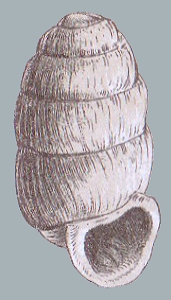Vertigo parcedentata is a species of minute, air-breathing land snail, terrestrial pulmonate gastropod molluscs or micromollusks in the family Vertiginidae, the whorl snails.[3]
| Vertigo parcedentata | |
|---|---|

| |
| Drawing: apertural view of a shell of Vertigo parcedentata | |
| Scientific classification | |
| Domain: | Eukaryota |
| Kingdom: | Animalia |
| Phylum: | Mollusca |
| Class: | Gastropoda |
| Order: | Stylommatophora |
| Family: | Vertiginidae |
| Subfamily: | Vertigininae |
| Genus: | Vertigo |
| Species: | V. parcedentata
|
| Binomial name | |
| Vertigo parcedentata | |
| Synonyms | |
| |
Distribution
editVertigo parcedentata was first described as a fossil from the loess of Wiesbaden, Germany.[4] The fossil distribution also includes other parts of Europe, from the Netherlands to Ukraine:[5] Pleistocene and alluvium of the Rhine valley in Germany,[6] Czech Republic,[5] Slovakia,[5] etc. Preece, White & Shchetnikov (2007)[7] had the first Holocene findings from the Baikal region.[4]
Until recently, this species was believed to be extinct.[4] Quite surprisingly, it was found alive in the Dovrefjell, Norway.[4] Meng (2008)[8] found evidence of the occurrence of Vertigo parcedentata in the Altay Mountains and Tien Shan.[4] In 2009 the material was photographed for the first time and compared with fossil material from Central Germany.[4] Pokryszko & Horsák (2007)[9] also found evidence of the recent occurrence of this species in the Altay region.[4]
The Recent distribution of this species includes:
- Dovrefjell, Norway[10]
- Altay Mountains in Russia[8]
- Tien Shan in Kyrgyzstan[8]
Description
editThe shell is small, narrowly ovate. The shell has a narrow umbilical crevice and blunt summit. The shell has from 41⁄2 to 5 convex whorls separated by a deeply impressed suture. The last whorl is forming half of the total length. The first whorl is entirely smooth, the rest having rather oblique striae, of which there are several finer between two stronger striae.[6]
The aperture is semiovate, obliquely truncate above, with weakly reflected margins that are connected by a very thin callus. The right margin is weakly arched forward. It has usually one or two teeth or is wholly toothless, but it can have up to 4 teeth.[6]
Authorities differ over the dimensions of the shell:
Ecology
editVertigo parcedentata inhabits soligenous and mixed calcareous fens.[1]
References
editThis article incorporates public domain text from reference[6] and CC-BY-3.0 text from the reference[4]
- ^ a b Neubert E. (2011). "Vertigo parcedentata". In: IUCN 2012. IUCN Red List of Threatened Species. Version 2012.2. <www.iucnredlist.org>. Downloaded on 1 November 2012.
- ^ (in German) Braun A. (1847). "Löss bei Krakau und an der Donau; Binnen-Konchylien darin". Neues Jahrbuch für Mineralogie, Geognosie, Geologie und Petrefakten-Kunde 1847: 49–54. Stuttgart.
- ^ MolluscaBase eds. (2022). MolluscaBase. Vertigo parcedentata (A. Braun, 1847). Accessed through: World Register of Marine Species at: https://www.marinespecies.org/aphia.php?p=taxdetails&id=1050671 on 2023-02-11
- ^ a b c d e f g h Meng S. & Hoffmann M. H. (2009). "Pupilla loessica Ložek 1954 (Gastropoda: Pulmonata: Pupillidae) – "A Living Fossil" in Central Asia?". Eiszeitalter und Gegenwart Quaternary Science Journal 58(1): 55–69. doi:10.3285/eg.58.1.03.
- ^ a b c d (in German) Ložek V. (1964). Quartärmollusken der Tschechoslowakei. Rozpravy Ústředního ústavu geologického, Vol. 31, Nakladatelství ČSAV, Praha, volume 31, 374 pp., 32 tables, 4 supplements, p. 206.
- ^ a b c d e Pilsbry H. A. & Cooke C. M. (1918-1920). Manual of Conchology. Second series: Pulmonata. Volume 25. Pupillidae (Gastrocoptinae, Vertigininae). Philadelphia. page 207.
- ^ Preece C. R., White D. & Shchetnikov A. A. (2007). "Holocene molluscan successions from the lake Baikal region, Siberia". World Congress of Malacology 2007: 172 (abstract).
- ^ a b c (in German) Meng S. (2008). "Neue Daten zur Verbreitung der Vertiginidae (Gastropoda: Pulmonata) in Zentralasien. [New distribution data for Vertiginidae (Gastropoda: Pulmonata) in Central Asia]". Mollusca 26(2): 207-219. PDF.
- ^ Pokryszko B. M. & Horsák M. (2007). "Pupilloidea (Pupillidae, Vertiginidae, Valloniidae, Gastrocoptinae) of the Altay – a travel in space time". World Congress of Malacology 2007: 170 (abstract).
- ^ a b Species summary for Vertigo parcedentata. AnimalBase, last modified 19 February 2009.
- Bank, R. A.; Neubert, E. (2017). Checklist of the land and freshwater Gastropoda of Europe. Last update: July 16, 2017
